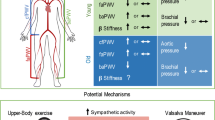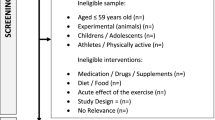Abstract
Purpose of Review
The aim of this systematic review and meta-analysis was to investigate the effect of resistance training on arterial stiffness (AS) in healthy subjects. Two electronic databases (PubMed and Scielo) were searched for randomized controlled trials comparing the effect of dynamic and/or isometric resistance training stand-alone versus non-exercise control group on AS assessed by pulse wave velocity (PWV) in healthy subjects. Random-effects modeling was employed to compare delta changes (post–pre-intervention) in AS between the resistance training and control group. Data were reported as weighted mean difference (MD) and its 95% confidence intervals (CI). Statistical significance was set at 5%.
Recent Findings
A total of 10 studies involving 310 participants (46.5% female; resistance training groups, n = 194; control groups, n = 116) were included in the meta-analysis. Comparing changes from pre- to post-resistance training groups versus control groups, no differences were observed in PWV (MD − 1.33 cm/s (95% CI − 34.58 to 31.91), p = 0.94, I2 = 91%).
Summary
Resistance training stand-alone does not elicit changes (i.e., improvement or impairment) on AS in healthy subjects, but the high heterogeneity suggests influence of training protocol and/or personal characteristics that should be investigated in the future.


Similar content being viewed by others
Data Availability
Data are available in the supplementary materials.
References
Papers of particular interest, published recently, have been highlighted as: • Of importance •• Of major importance
• Safar ME. Arterial stiffness as a risk factor for clinical hypertension. Nat Rev Cardiol. 2018;15:97–105. https://doi.org/10.1038/nrcardio.2017.155This is a very useful review about clinical aspects of aerterial stiffness in hypertension.
Franklin SS, Khan SA, Wong ND, Larson MG, Levy D. Is pulse pressure useful in predicting risk for coronary heart disease? Circulation. 1999;100:354–60. https://doi.org/10.1161/01.CIR.100.4.354.
Dolan E, Thijs L, Li Y, Atkins N, McCormack P, McClory S, et al. Ambulatory arterial stiffness index as a predictor of cardiovascular mortality in the Dublin outcome study. Hypertension. 2006;47:365–70. https://doi.org/10.1161/01.HYP.0000200699.74641.c5.
London GM, Guerin AP. Influence of arterial pulse and reflected waves on blood pressure and cardiac function. Am Heart J. 1999;138:S220–4. https://doi.org/10.1016/S0002-8703(99)70313-3.
•• Laurent S, Cockcroft J, Van Bortel L, et al. Expert consensus document on arterial stiffness: methodological issues and clinical applications. Eur Heart J. 2006;27:2588–605. https://doi.org/10.1093/eurheartj/ehl254This is an important consensus highlighting the pulse wave velocity as gold standard measure for arterial stiffness.
•• Thompson PD, Buchner D, Piña IL, et al. Exercise and physical activity in the prevention and treatment of atherosclerotic cardiovascular disease. Circulation. 2003;107:3109–16. https://doi.org/10.1161/01.CIR.0000075572.40158.77This AHA statement developed by experts is a reference base about the benefits of regular physical exercise in the prevention and treatment of cardiovascular diseases.
Zhang Y, Qi L, Xu L, Sun X, Liu W, Zhou S, et al. Effects of exercise modalities on central hemodynamics, arterial stiffness and cardiac function in cardiovascular disease: systematic review and meta-analysis of randomized controlled trials. PLoS One. 2018;13:e0200829. https://doi.org/10.1371/journal.pone.0200829.
Huang C, Wang J, Deng S, She Q, Wu L. The effects of aerobic endurance exercise on pulse wave velocity and intima media thickness in adults: a systematic review and meta-analysis. Scand J Med Sci Sports. 2016;26:478–87. https://doi.org/10.1111/sms.12495.
Montero D, Roche E, Martinez-Rodriguez A. The impact of aerobic exercise training on arterial stiffness in pre- and hypertensive subjects: a systematic review and meta-analysis. Int J Cardiol. 2014;173:361–8. https://doi.org/10.1016/j.ijcard.2014.03.072.
Miyachi M. Effects of resistance training on arterial stiffness: a meta-analysis. Br J Sports Med. 2013;47:393–6. https://doi.org/10.1136/bjsports-2012-090488.
Evans W, Willey Q, Hanson ED, Stoner L. Effects of resistance training on arterial stiffness in persons at risk for cardiovascular disease: a meta-analysis. Sport Med. 2018;48:2785–95. https://doi.org/10.1007/s40279-018-1001-6.
Johnson CP. Age related changes in the tunica media of the vertebral artery: implications for the assessment of vessels injured by trauma. J Clin Pathol. 2001;54:139–45. https://doi.org/10.1136/jcp.54.2.139.
Blacher J, Asmar R, Djane S, London ǴM, Safar ME. Aortic pulse wave velocity as a marker of cardiovascular risk in hypertensive patients. Hypertension. 1999;33:1111–7. https://doi.org/10.1161/01.HYP.33.5.1111.
Au JS, Oikawa SY, Morton RW, et al. Arterial stiffness is reduced regardless of resistance training load in young men. Med Sci Sport Exerc. 2017;49:342–8. https://doi.org/10.1249/MSS.0000000000001106.
Casey DP, Beck DT, Braith RW. Progressive resistance training without volume increases does not alter arterial stiffness and aortic wave reflection. Exp Biol Med. 2007;232:1228–35. https://doi.org/10.3181/0703-RM-65.
Cortezcooper M, Devan A, Anton M, et al. Effects of high intensity resistance training on arterial stiffness and wave reflection in women. Am J Hypertens. 2005;18:930–4. https://doi.org/10.1016/j.amjhyper.2005.01.008.
Cortez-Cooper MY, Anton MM, DeVan AE, et al. The effects of strength training on central arterial compliance in middle-aged and older adults. Eur J Cardiovasc Prev Rehabil. 2008;15:149–55. https://doi.org/10.1097/HJR.0b013e3282f02fe2.
Okamoto T, Masuhara M, Ikuta K. Effects of eccentric and concentric resistance training on arterial stiffness. J Hum Hypertens. 2006;20:348–54. https://doi.org/10.1038/sj.jhh.1001979.
Okamoto T, Masuhara M, Ikuta K. Upper but not lower limb resistance training increases arterial stiffness in humans. Eur J Appl Physiol. 2009;107:127–34. https://doi.org/10.1007/s00421-009-1110-x.
Okamoto T, Masuhara M, Ikuta K. Effects of muscle contraction timing during resistance training on vascular function. J Hum Hypertens. 2009;23:470–8. https://doi.org/10.1038/jhh.2008.152.
Okamoto T, Masuhara M, Ikuta K. Effect of low-intensity resistance training on arterial function. Eur J Appl Physiol. 2011;111:743–8. https://doi.org/10.1007/s00421-010-1702-5.
Okamoto T, Masuhara M, Ikuta K. Low-intensity resistance training after high-intensity resistance training can prevent the increase of central arterial stiffness. Int J Sports Med. 2012;34:385–90. https://doi.org/10.1055/s-0032-1312604.
Yasuda T, Fukumura K, Fukuda T, Uchida Y, Iida H, Meguro M, et al. Muscle size and arterial stiffness after blood flow-restricted low-intensity resistance training in older adults. Scand J Med Sci Sports. 2014;24:799–806. https://doi.org/10.1111/sms.12087.
Verhagen AP, de Vet HCW, de Bie RA, Kessels AGH, Boers M, Bouter LM, et al. The Delphi list. J Clin Epidemiol. 1998;51:1235–41. https://doi.org/10.1016/S0895-4356(98)00131-0.
Higgins J, Green S. Cochrane handbook for systematic reviews of interventions version 5.1.0 [updated March 2011]. 2011; The Cochrane Collaboration.
Higgins JPT. Measuring inconsistency in meta-analyses. BMJ. 2003;327:557–60. https://doi.org/10.1136/bmj.327.7414.557.
• Figueroa A, Okamoto T, Jaime SJ, Fahs CA. Impact of high- and low-intensity resistance training on arterial stiffness and blood pressure in adults across the lifespan: a review. Pflügers Arch. 2019;471:467–78. https://doi.org/10.1007/s00424-018-2235-8This review helps to explain the results about PWV and resistance training in the literature based on the segment of measurements.
•• Seals DR. Sympathetic neural discharge and vascular resistance during exercise in humans. J Appl Physiol. 1989;66:2472–8. https://doi.org/10.1152/jappl.1989.66.5.2472This study supports the rationale about resistance training increasing arterial stiffness.
Shirwany NA, Zou M. Arterial stiffness: a brief review. Acta Pharmacol Sin. 2010;31:1267–76. https://doi.org/10.1038/aps.2010.123.
Acknowledgments
The authors thank Fundação de Amparo à Pesquisa do Estado de São Paulo and also to all researchers who provided results making this study possible.
Funding
Fundação de Amparo à Pesquisa do Estado de São Paulo (FAPESP 2018/05226-0).
Author information
Authors and Affiliations
Contributions
J.C. and L.B. contributed to the study conception; J.C and L.A did the search of literature; E.C. contributed to the statistical analysis; J.C., E.C., and L.B. contributed to interpretation of data. All authors contributed to the critical revision of the manuscript.
Corresponding author
Ethics declarations
Conflict of Interest
The authors declare no conflicts of interest relevant to this manuscript.
Human and Animal Rights and Informed Consent
This article does not contain any studies with human or animal subjects performed by any of the authors.
Code Availability
Not applicable.
Additional information
Publisher’s Note
Springer Nature remains neutral with regard to jurisdictional claims in published maps and institutional affiliations.
This article is part of the Topical Collection on Guidelines/Clinical Trials/Meta-Analysis
Appendix
Appendix
Forest plot of the between-group comparison of the resistance training versus control group on absolute values of arterial stiffness assessed by the pulse wave velocity.

Rights and permissions
About this article
Cite this article
Ceciliato, J., Costa, E.C., Azevêdo, L. et al. Effect of Resistance Training on Arterial Stiffness in Healthy Subjects: A Systematic Review and Meta-Analysis. Curr Hypertens Rep 22, 51 (2020). https://doi.org/10.1007/s11906-020-01065-x
Published:
DOI: https://doi.org/10.1007/s11906-020-01065-x




